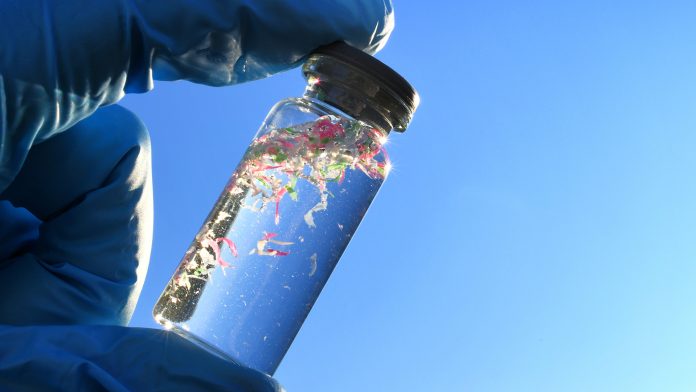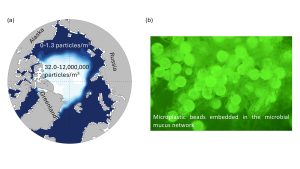Microplastics have reached even the remote Arctic Ocean, where they are found to be highly concentrated in Arctic sea ice.
Microplastics are small plastic particles with a < 5mm diameter. Microplastics are generated either directly by producing plastic beads smaller than 5mm, such as those used in skincare products, or indirectly by the breakdown of larger plastic objects, such as fishing nets, water bottles, and synthetic clothing. The indirect generation of microplastics from larger plastics is the dominant source of microplastic generation.
Plastics gained popularity in the 20th century due to their low weight, low cost, and longevity. However, while the longevity of plastics is a benefit during active usage, it poses a problem when plastics are disposed of.
Due to the rapid increase in plastic use over the past ~70 years and the mismanagement of waste, the amount of macro and microplastics entering the environment has increased. As a result, microplastics are now ubiquitous in the natural environment, having been found in rivers, soil, oceans, glaciers, and even in animals and the human body.
Microplastics in the Arctic Ocean and its sea ice cover
Since microplastics are so ubiquitous in the environment, it is perhaps unsurprising that they have also been found in the sparsely populated and remote Arctic Ocean. However, what is surprising is that the concentration of microplastics in Arctic sea ice is much higher than in the underlying Arctic Ocean (Fig. a). This high concentration of microplastics in Arctic sea ice was first shown in the early 21st century and has since been confirmed using more samples collected at different locations and in different years.
Impacts of microplastics in the Arctic sea ice
The high microplastic content of Arctic sea ice has several potential impacts.
First, sea ice stores and redistributes microplastics. As the Arctic sea ice cover has decreased in recent decades, this effect has likely become smaller, affecting the global distribution of microplastics in the ocean.
Second, as microplastics can be darker than the highly reflective sea ice they are incorporated in, they may be affecting the absorption of solar radiation in the ice, potentially affecting melt rates and, thus, the Arctic climate system. Solar radiation also penetrates through the ice into the underlying ocean; if microplastics reduce this, then there could be an impact on under-ice ecosystems which rely on this light source (e.g., phytoplankton).
Unknowns about microplastics in Arctic sea ice
It is currently unclear what causes the high concentration of microplastics in Arctic sea ice, relative to that found in the surface ocean underneath the sea ice where these samples have been taken. These high ice concentrations might simply reflect high concentration in the ocean surface layer of the shallow shelf seas of the Arctic Ocean where sea ice forms, as rivers potentially add large amounts of microplastics to these seas. The mismatch in microplastic concentration between sea ice and the surface ocean might then arise when samples are taken from ice that has moved away from the shelves, e.g., over some areas of the deep basins where ocean concentrations are lower.
However, an intriguing possibility is that high ice concentrations might directly result from the ice growth process, even in areas of relatively low ocean concentrations. The idea is that when sea ice forms, ice crystals within the upper ocean float upward and can collect ‘impurities’ such as sediment and microplastics, increasing their concentration in the sea ice.
Furthermore, microbial mucus forms a network of polymers (made up of carbohydrates, proteins, salt and water) that can concentrate microplastics in the water below sea ice (Fig. b) and thus in the sea ice that forms from this water.
In addition to unknowns about how the microplastics get concentrated in the Arctic sea ice, it is also unknown when microplastics are released from sea ice during melt, which affects microplastic concentrations in the surface ocean.
NSF-funded research project
To address these numerous unknowns about microplastics in the Arctic Ocean, we received funding for a project on sea ice-ocean exchange of Arctic microplastics from the Arctic System Science Program at the US National Science Foundation (NSF). We are using a combination of 1D and 3D numerical modelling and laboratory experimental work to provide new insights into how microplastics are incorporated into sea ice as it grows and how it is released as it melts.
In addition, this project also includes the development of a science curriculum about Arctic microplastics for secondary school teachers. This collaborative and interdisciplinary project includes scientists across the United States at the University of Washington Applied Physics Laboratory, the Institute for Systems Biology, the Woods Hole Oceanographic Institution, the National Center for Atmospheric Research, and the University of Colorado Boulder.
By collaborating across disciplines, we are striving to provide novel insights into the causes of high Arctic sea ice microplastic concentrations, as well as to understand the spatial variability of microplastics in the Arctic Ocean and its sea ice cover in a changing climate.
Furthermore, we are working to assess whether microplastics can affect the radiative properties of sea ice to a large enough extent that there is a detectable feedback onto the climate system. This knowledge will link the usually separately considered urgent problems of microplastic pollution and anthropogenic climate change.
Currently, our project is just starting to generate results that will provide answers to some of the many questions surrounding Arctic microplastics. We plan to provide a follow-up article in the future to describe our findings.
Please note, this article will also appear in the 20th edition of our quarterly publication.










